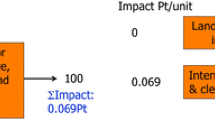Abstract
Purpose
This discussion article aims to highlight two problematic aspects in the International Reference Life Cycle Data System (ILCD) Handbook: its guidance to the choice between attributional and consequential modeling and to the choice between average and marginal data as input to the life cycle inventory (LCI) analysis.
Methods
We analyze the ILCD guidance by comparing different statements in the handbook with each other and with previous research in this area.
Results and discussion
We find that the ILCD handbook is internally inconsistent when it comes to recommendations on how to choose between attributional and consequential modeling. We also find that the handbook is inconsistent with much of previous research in this matter, and also in the recommendations on how to choose between average and marginal data in the LCI.
Conclusions
Because of the inconsistencies in the ILCD handbook, we recommend that the handbook be revised.
Similar content being viewed by others
References
Ahlgren S, Björklund A, Ekman A, Karlsson H, Berlin J, Börjesson P, Ekvall T, Finnveden G, Janssen M, Strid I (2015) Review of methodological choices in LCA of biorefinery systems—key issues and recommendations. Biofuels Bioprod Biorefin 9(5):606–619
Anex R, Lifset R (2014) Life cycle assessment: different models for different purposes. J Ind Ecol 18(3):321–323
Azapagic A, Clift R (1999) Allocation of environmental burdens in multiple-function systems. J Clean Prod 7(2):101–119
Brandão M, Clift R, Cowie A, Greenhalgh S (2014) The use of life cycle assessment in the support of robust (climate) policy making: comment on “using attributional life cycle assessment to estimate climate-change mitigation…”. J Ind Ecol 18(3):461–463
Curran MA, Mann M, Norris G (2005) The international workshop on electricity data for life cycle inventories. J Clean Prod 13(8):853–862
Dale BE, Kim S (2014) Can the predictions of consequential life cycle assessment be tested in the real world? Comment on “using attributional life cycle assessment to estimate climate-change mitigation…”. J Ind Ecol 18(3):466–467
Ekvall T (1999) System expansion and allocation in life cycle assessment—with implications for wastepaper management. PhD thesis. Dept. Technical Environmental Planning, Chalmers University of Technology, Gothenburg, Sweden
Ekvall T, Weidema B (2004) System boundaries and input data in consequential life cycle inventory analysis. Int J Life Cycle Assess 9(3):161–171
Ekvall T, Tillman A-M, Molander S (2005) Normative ethics and methodology for life cycle assessment. J Clean Prod 13(13-14):1225–1234
European Commission (2013a) Building the single market for green products. Facilitating better information on the environmental performance of products and organisations. COM(2013) 196 final, Brussels, 9.4.2013
European Commission (2013b) Commission Recommendation of 9 April 2013 on the use of common methods to measure and communicate the life cycle environmental performance of products and organisations. 2013/179/EU
European Commission (2015a) EEB-01-2016: Highly efficient insulation materials with improved properties. In: Horizon 2020 Work Programme 2016–2017: 5.ii. Nanotechnologies, Advanced Materials, Biotechnology and Advanced Manufacturing and Processing. European Commission Decision C (2015)6776 of 13 October 2015
European Commission (2015b) NMBP-06-2017: Improved material durability in buildings and infrastructures, including offshore. In: Horizon 2020 Work Programme 2016–2017: 5.ii. Nanotechnologies, Advanced Materials, Biotechnology and Advanced Manufacturing and Processing. European Commission Decision C (2015)6776 of 13 October 2015
Finnveden G (2008) A world with CO2-caps. Electricity production in consequential assessments. Int J Life Cycle Assess 13(5):365–367
Finnveden G, Hauschild MZ, Ekvall T, Guinée J, Heijungs R, Hellweg S, Koehler A, Pennington D, Suh S (2009) Recent developments in life cycle assessment. J Environ Manag 91(1):1–21
Hertwich E (2014) Understanding the climate mitigation benefits of product systems: comment on “using attributional life cycle assessment to estimate climate-change mitigation…”. J Ind Ecol 18(3):464–465
JRC-IEA (2010) International Reference Life Cycle Data System (ILCD) Handbook—General guide for Life Cycle Assessment—Detailed guidance. First edition March 2010. Publications Office of the European Union, Luxembourg. Available at http://lct.jrc.ec.europa.eu/
Laurent A, Clavreul J, Bernstad A, Bakas I, Niero M, Gentil E, Christensen TH, Hauschild MZ (2014) Review of LCA studies of solid waste management systems—Part II: methodological guidance for a better practice. Waste Manag 34(3):589–606
Mathiesen BV, Münster M, Fruergard T (2009) Uncertainties related to the identification of the marginal energy technology in consequential life cycle assessment. J Clean Prod 17(15):1331–1338
Plevin RJ, Delucchi MA, Creutzig F (2014a) Using attributional life cycle assessment to estimate climate-change mitigation benefits misleads policy makers. J Ind Ecol 18(1):73–83
Plevin R, Delucchi M, Creutzig F (2014b) Response to comments on “using attributional life cycle assessment to estimate climate-change mitigation…”. J Ind Ecol 18(3):468–470
Plevin RJ, Delucchi MA, Creutzig F (2014c) Response to “On the uncanny capabilities of consequential LCA” by Sangwon Suh and Yi Yang. Int J Life Cycle Assess 19(8):1559–1560. doi:10.1007/s11367-014-0739-9
Sonnemann G, Vigon B (2011) Global guidance principles for life cycle assessment databases. UNEP/SETAC Life Cycle Initiative, Paris/Pensacola
Suh S, Yang Y (2014) On the uncanny capabilities of consequential LCA. Int J Life Cycle Assess 19(6):1179–1184
Weidema BP (2009) Avoiding or ignoring uncertainty. J Ind Ecol 13(3):354–356
Weidema BP, Frees N, Nielsen A-M (1999) Marginal production technologies for life cycle inventories. Int J Life Cycle Assess 4:448–456
Zamagni A, Guinée J, Heijungs R, Masoni P, Raggi A (2012) Lights and shadows in consequential LCA. Int J Life Cycle Assess 17(7):904–918
Acknowledgments
Tomas Ekvall and Tomas Ryberg acknowledge the financial support provided for the writing of this article by the Swedish Research Council Formas and the Swedish Environmental Protection Agency through the Foundation for IVL Swedish Environmental Research Institute (SIVL).
Author information
Authors and Affiliations
Corresponding author
Additional information
Responsible editor: Mary Ann Curran
Rights and permissions
About this article
Cite this article
Ekvall, T., Azapagic, A., Finnveden, G. et al. Attributional and consequential LCA in the ILCD handbook. Int J Life Cycle Assess 21, 293–296 (2016). https://doi.org/10.1007/s11367-015-1026-0
Received:
Accepted:
Published:
Issue Date:
DOI: https://doi.org/10.1007/s11367-015-1026-0




